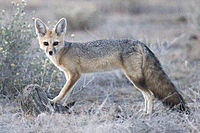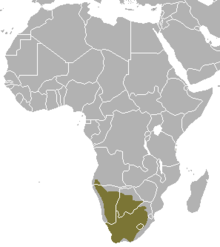Cape fox
| Cape fox | |
|---|---|
 |
|
| Adult feeding on a helmeted guineafowl in Etosha National Park | |
 |
|
| Cape fox kits | |
| Scientific classification | |
| Kingdom: | Animalia |
| Phylum: | Chordata |
| Class: | Mammalia |
| Order: | Carnivora |
| Family: | Canidae |
| Genus: | Vulpes |
| Species: | V. chama |
| Binomial name | |
|
Vulpes chama (A Smith, 1833) |
|
 |
|
| Cape fox range | |
| Synonyms | |
|
|
The Cape fox (Vulpes chama), also called the cama fox or the silver-backed fox, is a small fox.
It has black or silver gray fur with flanks and underside in light yellow. The tip of its tail is always black.
The Cape fox tends to be 45 to 61 cm (17.5 to 24 in) long, not including a 30 to 40 cm (12 to 15.5 in) tail. It is 28 to 33 cm (11 to 13 in) tall at the shoulder, and usually weighs from 3.6 to 5 kg (7.9 to 11.0 lb).
It inhabits mainly open country, from open grassland plains with scattered thickets to arid to semi desert scrub, and also extending into fynbos. It is widespread in Zimbabwe, Botswana, and South Africa, occurring in most parts of the Western and Northern Cape provinces, the Eastern Cape (excluding the southeastern side), the Free State, western and northwestern KwaZulu-Natal and the North-West province. It also occurs in Lesotho, a high mountainous region.
The Cape fox is nocturnal and most active just before dawn or after dusk; it can be spotted during the early mornings and early evenings. During the day, it typically shelters in burrows underground, holes, hollows, or dense thickets. It is an active digger that will excavate its own burrow, although it generally modifies an abandoned burrow of another species, such as the springhare, to its specific requirements. They are solitary creatures, and although they form mated pairs, the males and females are often found alone, as they tend to forage separately. They are not especially territorial but will mark their territories with a pungent scent. Although a normally silent fox, the Cape fox is known to communicate with soft calls, whines or chirps. However, it will utter a loud bark when alarmed. When in an aggressive mood, the Cape fox is known to growl and spit at its attacker. To show its excitement, the fox lifts its tail, the height of the tail often indicating the measure of excitement.
Cape foxes are omnivorous and will eat plants or animals. Although they prefer invertebrates and small mammals such as rodents, they are opportunists and known to hunt and eat reptiles, rabbits, spiders, birds, and young hares. They will also eat eggs, beetle larvae, and carrion, as well as most insects or fruits. Cape foxes have been reported to be able to kill lambs up to three months of age, although this is a rare occurrence.
...
Wikipedia

